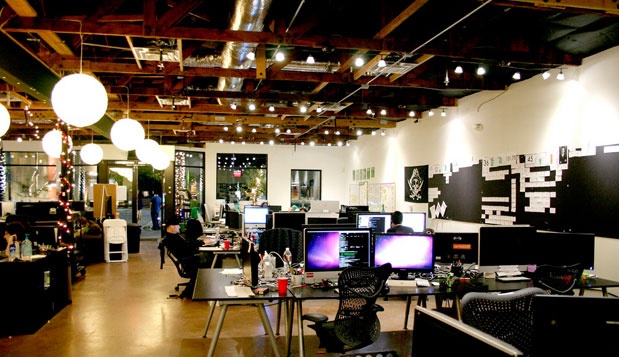shared workspaces can be very good for freelancers. Here are some of the benefits of shared workspaces for freelancers:
- Affordability: Shared workspaces are often more affordable than renting a traditional office space. This can be a big advantage for freelancers who are just starting out or who are on a tight budget.
- Flexibility: Shared workspaces are often more flexible than traditional office spaces. You can usually choose a membership that fits your needs, and you can often come and go as you please. This can be helpful for freelancers who have variable work schedules or who need to work from home sometimes.
- Community: Shared workspaces offer a sense of community. You can meet other professionals, collaborate on projects, and get support. This can be helpful for freelancers who can feel isolated working from home.
- Networking: Shared workspaces are a great place to network with other professionals. You can meet potential clients, partners, and employees. This can be helpful for freelancers who are looking to grow their business.
- Inspiration: Shared workspaces can be a great place to get inspired. You can see what other people are working on, and you can be motivated by the energy of the space. This can be helpful for freelancers who can get bogged down in their work.
If you’re a freelancer, we definitely recommend considering a shared workspace. It can be a great way to save money, be more flexible, and connect with other professionals.
When you’re in permanent employment one of the common complaints is the fact you have to stare at the same four walls the whole time. Your desk or cubicle becomes your entire world and your working day can go beyond repetitive into brain-numbingly monotonous. So the freedom that comes with being a freelancer is a blessing, right? Not always.
Working from home…
Assuming their line of work allows it, many freelance workers are forced to work from home. This might sound like a dream come true for lots of people, who would readily swap their daily commute for rolling straight out of bed into work. But there can be some very real drawbacks:
- Anyone working from home will need a dedicated desk, office or workspace that can accommodate them and the materials they need for their work. The sheer number of hours spent working will mean you need a comfortable and practical space to work in. Hunching over your laptop on a spongy sofa could lead to some serious back problems.
- Since your ability to work will likely hinge on a working computer and reliable internet connection, you’ll need to make sure you’re covered. Unlike in an office, free technical assistance will not be on the other end of the phone when you work from home.
- Working from home requires a great deal of self-restraint; being able to stop working at the end of the working day, rather than let it bleed into your free time isn’t easy. Conversely, forcing yourself to work when you’re surrounded by distractions requires serious self-control.
- The expense of heating your home and covering electricity all day every day is probably more than you’d imagine. Freelancers who work from home incur these costs simply by being there.
- Finally, and perhaps most importantly there’s the sociability factor. The occasional cup of coffee with your workmates, a chat at your desk and grabbing a quick lunch with colleagues are underrated when you have them every day but you miss them when they’re gone. People who work from home are usually completely deprived of company throughout the day, which can sometime actually lead to a decline in focus and productivity.
A smart alternative…
Co-working: The Middle Ground Workspace
Working from home full time works for some people, but for those looking for a sociable alternative there are shared workspaces, also known as co-working spaces. These tend to be open-plan areas set up in inner city locations for individuals who don’t want to work from home full time but can’t necessarily afford an office. The idea is that you rent a desk instead, in a way that is as flexible as you need it to be. Let’s look at the advantages of working in this way:
1) Meet like-minded people
21 Inspirational Collaborative Workspaces
Sociability has to be the biggest benefit of shared workspaces. Miami Shared offers a great example of the type of mix you’ll find in co-working spaces. Amongst the sixty members signed up to use the space there are small tech start-ups, creative professionals and new media freelancers as well as lawyers, financial advisers, and real estate brokers, who like to hang out there simply because of the relaxed, collaborative vibe.
As well as being sociable, working in close proximity with like-minded people can be great for business. Collaboration is far more likely if you chat with someone informally in person than if you approach them cold. Going back to the example of Miami Shared, they actually host workshops, speaking events and networking mixers, all of which aim to nurture the Miami tech community.
2) Save cash
Co-working brings savings, networking for tech startups
Each shared working space operates differently, with some offering membership on a monthly basis and others charging per hour. The Cube in London offers places for one to five workers at £25 per hour for non-members and £15 per hour for members. Meanwhile The Grind in New York boasts a day rate of $35 and a monthly rate of $500. Since flexibility is the name of the game with shared workplaces, most will offer a deal that will suit your needs. Then of course there are different perks thrown in, The Trampery in London’s Shoreditch offers free tea and coffee while pariSoma in San Francisco boasts a couple of Google bikes for coworkers to use.
3) Enjoy real flexibility
The top 10 shared office space options in Toronto
As mentioned above the sheer range of shared working spaces out there means there is a great diversity of offerings. Whether you simply need a space to meet with clients once a week or a full time desk to get you out of your flat during the working day, you should be able to find something. Most places tend to section off the space to separate more regular workers with those who are only in for a flying visit. As such most offer different types of desk for different types of work.
4) Do some good for the environment
At Shared Offices, How Green Is My Work Space
Forget heating your home all day every day and paying extortionate daytime electricity bills by getting a shared office to foot the utility bill instead. This saving will come hand in hand with leaving a smaller carbon footprint. Then there are places like Greenspaces in Denver, which take this one step further thanks to their focus on sustainability and the environment. This Denver shared workspace is a solar-powered facility, replete with soft cork flooring in the restrooms and original concrete elsewhere, all-natural clay walls with no VOC paint and solar tube light fixtures.
5) Work somewhere cool
16 Cool Coworking Spaces
If the examples above haven’t already persuaded you, this compilation of 16 cool co-working spaces should convince you that shared workspaces can be painfully hip and impressively dynamic. Working somewhere you like and are proud of can be a great morale-booster for a professional freelance worker. But that isn’t the only bonus; being able to meet clients somewhere that has a forward-thinking buzz about it is bound to impress.

